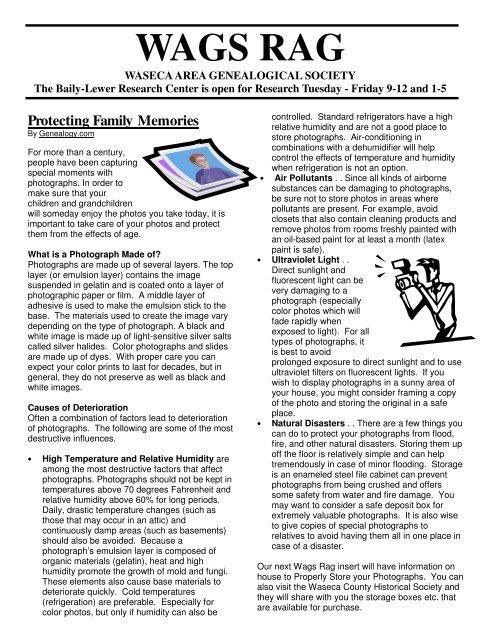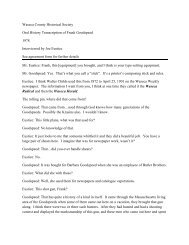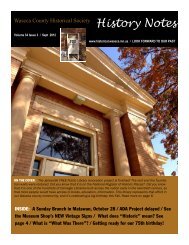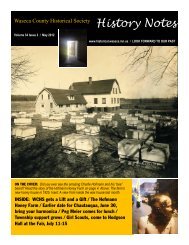August 2010 - Waseca County Historical Society
August 2010 - Waseca County Historical Society
August 2010 - Waseca County Historical Society
You also want an ePaper? Increase the reach of your titles
YUMPU automatically turns print PDFs into web optimized ePapers that Google loves.
WAGS RAG<br />
WASECA AREA GENEALOGICAL SOCIETY<br />
The Baily-Lewer Research Center is open for Research Tuesday - Friday 9-12 and 1-5<br />
Protecting Family Memories<br />
By Genealogy.com<br />
For more than a century,<br />
people have been capturing<br />
special moments with<br />
photographs. In order to<br />
make sure that your<br />
children and grandchildren<br />
will someday enjoy the photos you take today, it is<br />
important to take care of your photos and protect<br />
them from the effects of age.<br />
What is a Photograph Made of<br />
Photographs are made up of several layers. The top<br />
layer (or emulsion layer) contains the image<br />
suspended in gelatin and is coated onto a layer of<br />
photographic paper or film. A middle layer of<br />
adhesive is used to make the emulsion stick to the<br />
base. The materials used to create the image vary<br />
depending on the type of photograph. A black and<br />
white image is made up of light-sensitive silver salts<br />
called silver halides. Color photographs and slides<br />
are made up of dyes. With proper care you can<br />
expect your color prints to last for decades, but in<br />
general, they do not preserve as well as black and<br />
white images.<br />
Causes of Deterioration<br />
Often a combination of factors lead to deterioration<br />
of photographs. The following are some of the most<br />
destructive influences.<br />
• High Temperature and Relative Humidity are<br />
among the most destructive factors that affect<br />
photographs. Photographs should not be kept in<br />
temperatures above 70 degrees Fahrenheit and<br />
relative humidity above 60% for long periods.<br />
Daily, drastic temperature changes (such as<br />
those that may occur in an attic) and<br />
continuously damp areas (such as basements)<br />
should also be avoided. Because a<br />
photograph’s emulsion layer is composed of<br />
organic materials (gelatin), heat and high<br />
humidity promote the growth of mold and fungi.<br />
These elements also cause base materials to<br />
deteriorate quickly. Cold temperatures<br />
(refrigeration) are preferable. Especially for<br />
color photos, but only if humidity can also be<br />
controlled. Standard refrigerators have a high<br />
relative humidity and are not a good place to<br />
store photographs. Air-conditioning in<br />
combinations with a dehumidifier will help<br />
control the effects of temperature and humidity<br />
when refrigeration is not an option.<br />
• Air Pollutants . . Since all kinds of airborne<br />
substances can be damaging to photographs,<br />
be sure not to store photos in areas where<br />
pollutants are present. For example, avoid<br />
closets that also contain cleaning products and<br />
remove photos from rooms freshly painted with<br />
an oil-based paint for at least a month (latex<br />
paint is safe).<br />
• Ultraviolet Light . .<br />
Direct sunlight and<br />
fluorescent light can be<br />
very damaging to a<br />
photograph (especially<br />
color photos which will<br />
fade rapidly when<br />
exposed to light). For all<br />
types of photographs, it<br />
is best to avoid<br />
prolonged exposure to direct sunlight and to use<br />
ultraviolet filters on fluorescent lights. If you<br />
wish to display photographs in a sunny area of<br />
your house, you might consider framing a copy<br />
of the photo and storing the original in a safe<br />
place.<br />
• Natural Disasters . . There are a few things you<br />
can do to protect your photographs from flood,<br />
fire, and other natural disasters. Storing them up<br />
off the floor is relatively simple and can help<br />
tremendously in case of minor flooding. Storage<br />
is an enameled steel file cabinet can prevent<br />
photographs from being crushed and offers<br />
some safety from water and fire damage. You<br />
may want to consider a safe deposit box for<br />
extremely valuable photographs. It is also wise<br />
to give copies of special photographs to<br />
relatives to avoid having them all in one place in<br />
case of a disaster.<br />
Our next Wags Rag insert will have information on<br />
house to Properly Store your Photographs. You can<br />
also visit the <strong>Waseca</strong> <strong>County</strong> <strong>Historical</strong> <strong>Society</strong> and<br />
they will share with you the storage boxes etc. that<br />
are available for purchase.
















